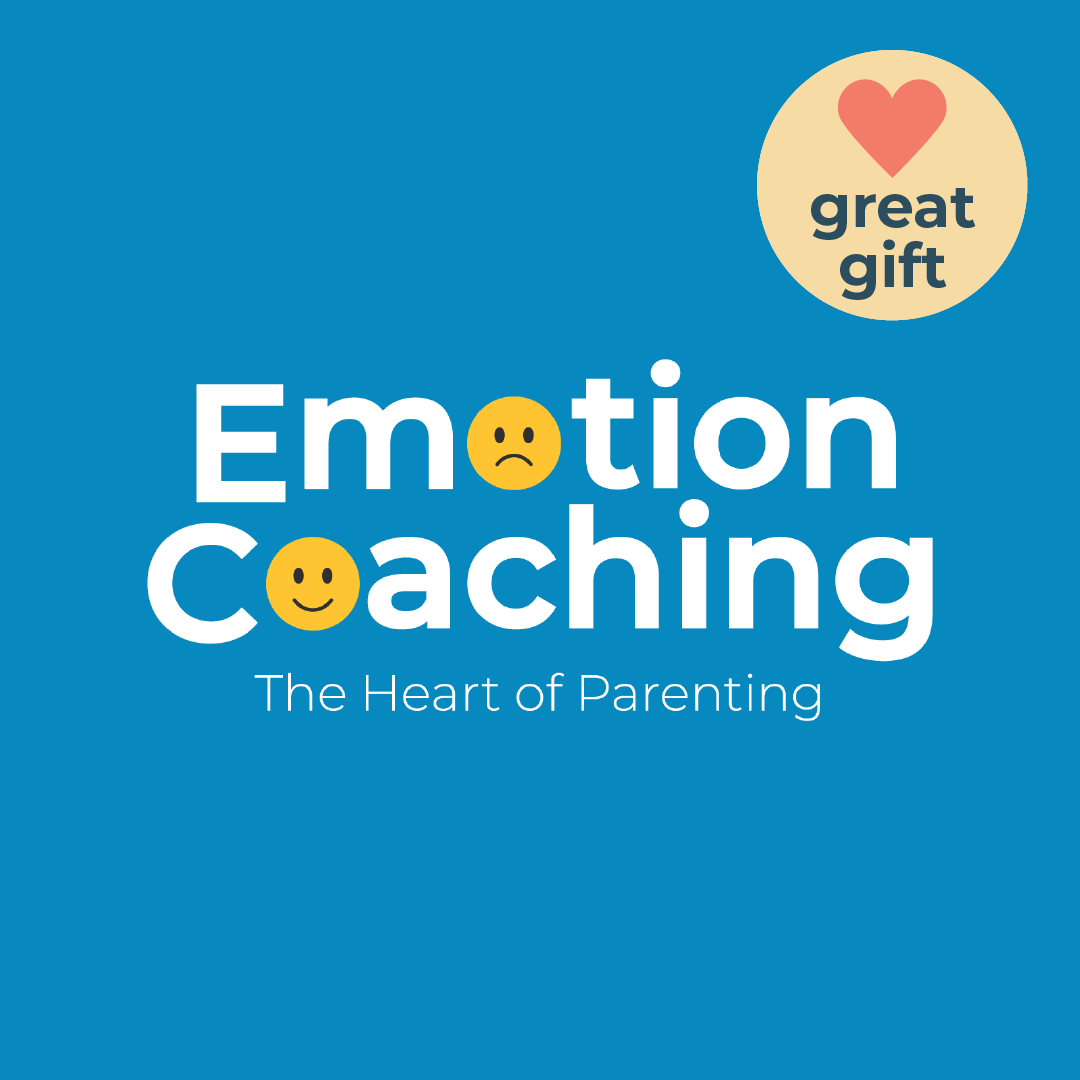“There is no friendship, no love, like that of the parent for the child.”
–Henry Ward Beecher

Friendship and love may seem like a given token to a deep connection with your child. Despite best intentions as a parent, forming and keeping a strong bond may not always be simple. How can you better your relationship with your child? How can you gain the type of close relationship you’ve been yearning for? The answer can be found in Emotion Coaching.
Emotion Coaching: The Heart of Parenting is presented by John Gottman, Ph.D. and Julie Schwartz Gottman, Ph.D. World-renowned psychologist and co-founder of the Gottman Institute, Dr. John Gottman is known for his substantial work in marriage stability, parenting, and divorce predictions. Not only has he conducted over fifty years of research with thousands of couples, but has received a plethora of major awards for his contributions. Dr. Julie Schwartz Gottman, psychologist, co-founder, and President of the Gottman Institute, is an expert advisor on marriage, sexual harassment, rape, domestic violence, adoption, same-sex marriage, and parenting issues.

The Gottman Institute’s Emotion Coaching is a research-based method which teaches parents how to assist in recognizing, responding to, and regulating their child’s behaviors and emotions. The Gottmans introduce five key points of focus for Emotion Coaching, which are Be Aware of Your Child’s Emotions, Recognize Emotion as an Opportunity for Connection and Teaching, Help Your Child Verbally Label Emotions, Communicate Empathy and Understanding, and Set Limits and Problem Solve.
Despite assistance from guides, websites, or even other parents, the task of being the best parent possible when raising a child can feel overwhelming. How can one quantify “good parenting”? The Gottman Institute found that building emotional intelligence to be the key for parents and children alike. Emotion Coaching provides the tools and information to create the foundation for garnering higher emotional intelligence. Being able to instill healthy coping skills, fostering a safe space, and providing an opportunity for bonding are only a few of the things which can be accomplished through Emotion Coaching.
Why does Emotion Coaching spark interest? Maybe you hope to pick up new and effective parenting strategies and think Emotion Coaching could be right for you. Or perhaps, you’ve noticed yourself becoming more and more overwhelmed or flooded by emotions when dealing with the struggles of parenting. Daniel Siegel terms the flooding process, “flipping our lids” as the frontal cortex (brain’s lid) relinquishes ability to control the limbic system’s alarm physiology. Children and parents alike can become overwhelmed, angry, upset, and lose sight of reasoning when in stressful situations.

Giving your child the opportunity to join in the journey of their Emotional Coaching goes beyond a simple fix; doing so creates opportunities for further emotional connection by allowing your child to work alongside you, developing strategies and learning about their own emotional needs and wants, to be part of the solution.
The 5 Steps of Emotion Coaching are broken down below:
Step 1: Be Aware of Your Child’s Emotions
The first step is in understanding the importance of emotional intelligence and defining what that term means. Emotional intelligence highlights the ability to identify and understand not only one’s own emotions, but to empathize with others’ emotions in a cooperative manner. Coinciding with emotional intelligence is emotional regulation, which is how effectively one can manage feelings. Understanding the interplay of emotional intelligence and emotional regulation is vital and often overlooked in parenting.
As a rule of thumb, an Empathetic Statement = Name the Feeling + Validate the Feeling. Being aware of your child’s emotions sews the seeds of knowing your child at a deeper level.
Step 2: Recognize Emotion as an Opportunity for Connection and Teaching
Recognizing emotion can include paying attention to facial, gestural, and verbal cues from your child. Not all children are proficient at articulating thoughts and feelings. Body language can give key insight and provide opportunities for emotional connection. All children are different and may have different emotional cues, so it is important to pay mind to that, as well.
Children pass through different stages of development. During their preschool years (up to age 7), the focus should be on learning emotional regulation through fantasy play. The outcome of this would be children learning to label, understand, and regulate their emotions. During the middle childhood years (ages 8-12), the focus will be to think logically, reason, and problem solve through discussion and sharing. The outcome would be children choosing to speak and parents actively listening at these times. For adolescent years (age 12+), children attempt to integrate reason with emotions through the process of exploring identities. The outcome would be parents listening, respecting, and being patient with their child’s opinions as they continue to develop.
Step 3: Help Your Child Verbally Label Emotions
Learning to label emotions is one of the first steps to navigating them. Creating lists of emotion words together to have the child pick and choose is a great place to start in emotion identification. “Today I feel ____,” is an example of how that could look. For older children or teenagers, a journal or feeling log can be beneficial.

Step 4: Communicate Empathy and Understanding
Empathy and understanding are the heart of successful parenting along with being an effective Emotion Coach. The crux of empathy is not to solve an issue or give advice, but rather to hear what your child is saying. Recognize that expressions of emotion are an opportunity for connection. There are a plethora of different parenting styles and no one parenting style is correct. Being flexible in parenting while keeping empathy at the core of every interaction shows profound positive effects on the behavior and health of children and will only deepen that connection with your child.
Step 5: Set Limits and Problem Solve
Like you, your child can face a multitude of different stressors in their day. This may take the form of arguments with peers of siblings, worries about schoolwork, or maybe negative thoughts about themself. A big part of problem solving is being present for your child and helping them through a challenge. Guiding principles to follow when setting limits and problem solving can look like:
- Confronting your child, providing choices, and a reason for limit setting that is connected to the misbehavior.
- State the rules and summarize the situation.
- Clearly define the consequences for the misbehavior. Keep in mind that the consequences should be appropriate for the child’s age and not unduly harsh.
- Use punishment, but only if necessary.
- Further problem solve if there is misbehavior.
Of equal importance is being mindful of how you react to your child’s problems. It can be harmful if parents dismiss or disapprove of a child’s emotions. To dismiss would mean that, although the parent has good intentions, they may minimize, discourage, or ignore negative emotions in an effort to protect their child. To disapprove would be to enact a punishment on a child for expressing emotions such as anger, to look down on introspection, and to strictly focus on reason rather than emotional control.

Results of parenting in these manners force the child to suppress rather than express negative emotions. A child may be less likely to communicate negative emotions in the future with the parent, and may turn to more destructive means of dealing with emotions. When conflict does arise between you and your child, it can be human nature to react negatively. However, it is vital not to respond to your child with behaviors such as criticism, which would be framing a behavior to be an inherent personality flaw rather than a problem to be improved upon. Defensiveness is another common reaction, which would be used to protect against feeling attacked or blamed. Contempt, which would be a statement made from a place of superiority in order to put someone down and stonewalling, which is withdrawing from an interaction and growing silent to minimize stimulation, are two other common behaviors to watch out for.
As quoted by John Gottman, “Our children can tell us so much.”
For parents who strive to do their best in being emotionally responsive, Emotion Coaching proves to be an effective resource in navigating the emotional responses of children and teenagers alike. Remember that Emotion Coaching is a continuous process that takes time and patience to implement. But with consistency, the relationship you share with your child will not only be strengthened, but it will flourish.

Interested in learning more about Emotion Coaching? Dr. Suzanna Freerksen has trained with the Gottman Institute and Group Parenting classes at Reclaim Joy Medical will soon be available. Check out our services page for more details.
Potential clients wishing to start therapy right away may book a free 15 minute phone introduction with Dr. Suzanna Freerksen to discuss individual and family therapy options. Dr. Freerksen treats adolescents ages 14 years old and older.
Author Kara Macris is a pre-med student with a BA from the University of Minnesota in Twin Cities, and a BS from Northwestern Health Sciences University. She currently works as a behavioral therapist for students with special needs.
